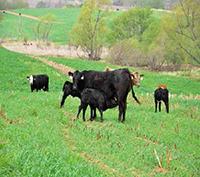Grazing Cover Crops
 The amount of pasture acres has decreased in Kentucky the last several years while the amount of row crop acres has increased. With this increase in row crop acres, grazing cover crops in cropping rotations has generated some interest. People feel that grazing cover crops is the final step in making a cover crop program reach its full potential. Producers who are in the crop business as well as the beef cattle industry say that grazing cover crops helps significantly save on feeding costs. Research has shown cover crops help improve the soil health at the same time. Before deciding to graze cover crops, several points should be considered.
The amount of pasture acres has decreased in Kentucky the last several years while the amount of row crop acres has increased. With this increase in row crop acres, grazing cover crops in cropping rotations has generated some interest. People feel that grazing cover crops is the final step in making a cover crop program reach its full potential. Producers who are in the crop business as well as the beef cattle industry say that grazing cover crops helps significantly save on feeding costs. Research has shown cover crops help improve the soil health at the same time. Before deciding to graze cover crops, several points should be considered.
The first consideration is, are you already in the cropping business? If so, any initial cost for equipment is already considered, as the same equipment is used to plant cover crops. The cover crop is often planted in late fall after row crops have been harvested. Cover crops help keep soils from washing, blowing, or simply being left bare for several months. Using cover crops during winter months can help control nutrient levels in the soil.
Many different varieties of forages can be used as cover crops. They can serve many different purposes, one of those being feed for grazing livestock. Common choices for cover crops include wheat, radishes, cereal rye, and crimson clover. Many producers who use cover crops for grazing have successfully used a mixture of wheat and cereal rye.
Selection of what to seed as a cover crop will depend on what time of year the row crop gets harvested. Additional considerations include: The cost of seed, whether you want a cover that survives the winter, and whether you want a grass versus a legume. The most common cover crop used in Kentucky is wheat because it can be planted late in the fall, October 1-15, provides a good quality forage, is high yielding, and is fairly inexpensive. Cereal rye is similar to wheat except it produces more fall growth for late season grazing, but it is lower on quality once the seedhead emerges. Some producers may plant crimson clover, or include crimson clover in their cover crop planting. The challenge with this species is it has a tendency to winter kill. Radishes are not ideal for grazing because the cattle will pull them out of the ground and generally will not eat the bulbs. The Natural Resource and Conservation Service has a mixture of different species that some producers use for grazing as well.
Lengthening the grazing season by grazing cover crops during late fall through early spring can help save money on hay costs. If a beef cattle producer does not have row crops or the equipment, they may be able to contract with a neighboring crop farmer to graze their cover crops.
Another consideration is the class of cattle you intend to graze the cover crops. Using cover crops can be a great way to put weight on growing cattle without a lot of expense. On the other hand, it may not be economical to graze dry cows on cover crops since they do not require such high quality forage to keep body condition. Nutritional requirements vary among cattle classes, as will performance from these forages, so consider this before investing money into cover crops for grazing or make sure to graze cover crops with growing animals or for milk production.
The soil type in a field can affect the ability to graze cover crops. You may not know the exact name of the soil types on your farm, but likely have a good feel for the productivity and the moisture holding capacity. Generally, early spring is a wet time of the year. Soils that are extremely heavy and wet are problematic because cattle can cause compaction and create muddy areas in the field. A lot of soils in Kentucky are sloped or rolling and have good drainage so this is not a major concern for most producers.
The fencing situation is also something a producer needs to consider. Most cropland is not fenced. A producer has to ask themselves what amount of fence are they comfortable with installing. For fields that have a good perimeter fence but no interior fence, temporary strip fencing can be used to graze cover crops and maximize forage usage. Using temporary fencing solely, a producer must think about the temperament of his/her cattle, and if they trust only having a perimeter fence with a couple strands of wire. If no perimeter fence exists, and an excessive amount of fencing supplies are needed, it may not be financially feasible for a producer to graze cover crops.
Cover crops can be an economical source of high quality forage to extend the grazing season when used properly. Not everyone will be able to use cover crops in their operation, but those that can should consider grazing these forages in the spring. For those who do not have access to cover crops, cover crop species can be part of the pasture renovation process. For more information, contact your local extension agent or UK publication ID-113 Winter Cover Crops for Kentucky Gardens and Fields.
Categories:
Fall
Extending the Grazing Season


